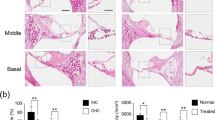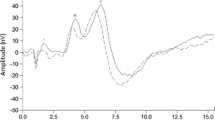Summary
Electrophysiological and histological observations in guinea pig's cochleas after amikacin treatment (14 × 450 mg/kg) confirm the results obtained in a former experiment: clear, short-latency, click-evoked responses were recorded in cochleas with only very few hair cells remaining at the extreme apex. Detailed analysis of these responses strongly indicates a neural origin and confirms their low-frequency sensitivity. Careful histological observations confirm the extensive hair cell loss and the preservation of nerve fibers in the remnants of the organ of Corti and of the vestibular sense organs. These results suggest that the acoustical vibrations either stimulate the vestibular receptors or act directly or through some kind of mechano-electrical transduction on the remaining cochlear nerve fibers.
Similar content being viewed by others
References
Aran, J.-M.: Neural correlates of electrically-induced cochlear dysfunction. Clin. Otolaryngol. 2, 305–310 (1977)
Aran, J.-M., Cazals, Y.: Electrocochleography: animal studies. In: Evoked electrical activity in the auditory nervous system. Naunton, R. F., Fernandez, C. (eds.), pp. 239–257. London: Academic Press 1978
Aran, J.-M., Cazals, Y., Erre, J.-P., Guilhaume, A.: Conflicting electrophysiological and anatomical data from drug impaired guinea pig cochleas. Acta Otolaryngol. (Stockh.) (in press) (1979)
Aran, J.-M., Darrouzet, J.: Observation of click-evoked compound VIII nerve responses before, during, and over seven months after kanamycin treatment in the guinea pig. Acta Otolaryngol. (Stockh.) 79, 24–32 (1975)
Aran, J.-M., Erre, J.-P.: Long-term recording of cochleo-neural potentials. In: Technical basis of auditory investigations. Engineering in Medicine. Beagley, H. A. (ed.). Oxford: Oxford University Press 1979
Evans, E. F.: The frequency response and other properties of single fibres in the guinea-pig cochlear nerve. J. Physiol. 226, 263–297 (1972)
Lowenstein, O., Roberts, T. D. M.: Oscillographic analysis of the gravity and vibration responses from the labyrinth of the thornback ray (Raja clavata). Nature 162, 852–853 (1948)
Lowenstein, O., Roberts, T. D. M.: The localization and analysis of the responses to vibration from the isolated elasmobranch labyrinth: a contribution to the problem of the evolution of hearing in vertebrates. J. Physiol. 114, 471–489 (1951)
Townsend, G. L., Cody, D. T. R.: The averaged inion response evoked by acoustic stimulation: its relation to the saccule. Ann. Otol. Rhinol. Laryngol. 80, 121–131 (1971)
Author information
Authors and Affiliations
Additional information
This work was supported by INSERM grant 8-ASR-6
Rights and permissions
About this article
Cite this article
Cazals, Y., Aran, J.M., Erre, J.P. et al. “Neural” responses to acoustic stimulation after destruction of cochlear hair cells. Arch Otorhinolaryngol 224, 61–70 (1979). https://doi.org/10.1007/BF00455225
Issue Date:
DOI: https://doi.org/10.1007/BF00455225




